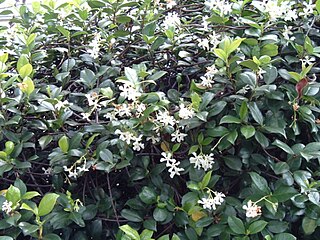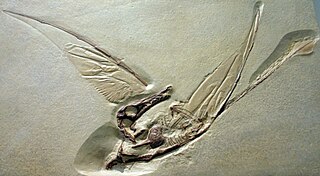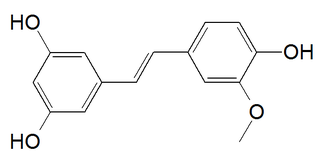
Catechin is a flavan-3-ol, a type of natural phenol and antioxidant. It is a plant secondary metabolite. It belongs to the group of flavan-3-ols, part of the chemical family of flavonoids.
Epigynum is a genus of plant in the family Apocynaceae. It has 5 known species.
Chimonocalamus is a genus of Asian bamboo in the grass family. It is native to China, the eastern Himalayas, and northern Indochina. Some of the species are aromatic and grown as ornamental plants.

TrachelospermumStar Jasmine, Confederate Jasmine, is a genus of evergreen woody vines in the dogbane family Apocynaceae, first described as a genus in 1851. All species are native to southern and eastern Asia.

Piper auritum, also known as hoja santa, yerba santa, hierba santa, Mexican pepperleaf, acuyo, tlanepa, anisillo, root beer plant, Vera Cruz pepper and sacred pepper, is an aromatic herb with a heart-shaped, velvety leaf which grows in tropic Mesoamerica.
Phytoecdysteroids are plant-derived ecdysteroids. Phytoecdysteroids are a class of chemicals that plants synthesize for defense against phytophagous insects. These compounds are mimics of hormones used by arthropods in the molting process known as ecdysis. When insects eat the plants with these chemicals they may prematurely molt, lose weight, or suffer other metabolic damage and die.

Nobuyuki Tanaka is an economic botanist at the Tokyo Metropolitan University, the Makino Botanical Garden in Kōchi Prefecture, Japan.

RANBP2-like and GRIP domain-containing protein 5 is a protein that in humans is encoded by the RGPD5 gene.

Hymenachne is a genus of widespread wetlands plants that is in the grass family. They may be known commonly as marsh grasses. They are distributed in tropical and subtropical regions of Asia, the Americas, and the Pacific Islands. A species from the Americas, H. amplexicaulis, is well known in other parts of the world as an introduced and invasive species.
4-Hydroxybenzaldehyde is one of the three isomers of hydroxybenzaldehyde. It can be found in the orchids Gastrodia elata, Galeola faberi, and the Vanilla orchids.

Huáng bǎi, huáng bó (黃柏) or huáng bò (黃檗) is one of the fifty fundamental herbs of traditional Chinese medicine. Known also as Cortex Phellodendri, it is the bark of one of two species of Phellodendron tree: Phellodendron amurense or Phellodendron chinense.

Rhamphorhynchidae is a group of early "rhamphorhynchoid" pterosaurs named after Rhamphorhynchus, that lived in the Late Jurassic. The family Rhamphorhynchidae was named in 1870 by Harry Govier Seeley.
Huia is a genus of extinct vascular plants of the Early Devonian. The genus was first described in 1985 based on fossil specimens from the Posongchong Formation, Wenshan district, Yunnan, China.
Gumuia is a genus of extinct vascular plants of the Early Devonian. The genus was first described in 1989 based on fossil specimens from the Posongchong Formation, Wenshan district, Yunnan, China.
Jianchangopterus is a genus of scaphognathine rhamphorhynchid pterosaur from the Middle Jurassic of western Liaoning, China. Jianchangopterus is known from a nearly complete skeleton with skull preserved. It was collected from the Tiaojishan Formation. It was first named by Lü Junchang and Bo Xue in 2011 and the type species is Jianchangopterus zhaoianus.
Galeola faberi is an orchid species in the genus Galeola found in central and southern China, as well as in Nepal, the eastern Himalayas, Vietnam and Sumatra.
Huwentoxins (HWTX) are a group of neurotoxic peptides found in the venom of the Chinese bird spider Haplopelma schmidti. The species was formerly known as Haplopelma huwenum, Ornithoctonus huwena and Selenocosmia huwena. While structural similarity can be found among several of these toxins, HWTX as a group possess high functional diversity.

Isorhapontigenin is a tetrahydroxylated stilbenoid with a methoxy group. It is an isomer of rhapontigenin and an analog of resveratrol. It is found in the Chinese herb Gnetum cleistostachyum, in Gnetum parvifolium and in the seeds of the palm Aiphanes aculeata.
Corydalis yanhusuo is a plant species in the genus Corydalis. The Chinese name for Corydalis yanhusuo is yan hu suo. The Japanese common name is engosaku (エンゴサク) and the Korean common name is hyeonhosaek (현호색). English common names include yanhusuo, corydalis, and Asian corydalis. The tuber of this plant, frequently mislabeled as the root, is an important therapeutic agent in traditional Chinese medicine. It is native to high-altitude grasslands across China including in the provinces of Anhui, Henan, Hubei, Hunan, Jiangsu, and Zhejiang, but is more widely cultivated.
Oreta speciosa is a moth in the family Drepanidae. It was described by Felix Bryk in 1943. It is found in China and Myanmar.








